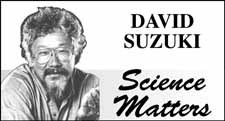December has traditionally been a time for people in the Northern Hemisphere to celebrate light. The nights get longer until December 21, when the North Pole is tilted furthest from the sun, and then light returns as the days start to grow longer.
Chanukah is a Jewish celebration of light. Christianity celebrates the birth of Jesus, who is often represented as light. Our word yule comes from the pre-Christian Scandinavian tradition of lighting fires to celebrate the warmth and light of the returning sun. Many indigenous people have also celebrated the shift to longer days and the impending rebirth of life when plants would spring up and animals would emerge from hibernation.
We get almost all of our light - and energy - from the sun. Most of it is in the form of visible light, but some is higher-energy ultraviolet light and some is lower-energy infrared light. This light gets converted to other forms of energy through a variety of fascinating processes.
People have been using energy to create light in the same way as the sun - with heat - for centuries. From the fire of torches and candles to the incandescent light bulb, we have found ways to bring both light and warmth into our lives.
Light is produced by energizing atoms. The most basic way to do this is to heat the atoms. At low temperatures, you get red, but the more atoms you energize, the brighter the light gets. The brightest is white, which is not a colour at all but is made up of many different colour frequencies.
Colour itself is created through our perception of light waves at different frequencies. We see colour either as light waves emitted from an object at a particular frequency or as the waves that are reflected back when the object absorbs other frequencies. We see plants as green because chlorophyll pigments absorb light photons in a way that makes the wavelength appear to us as green, and this pigment masks less-dominant ones. In the fall, when leaves stop producing these pigments and the chlorophyll breaks down, other pigments are uncovered, appearing as red, orange, and yellow.
Plants capture light from the sun and convert it to chemical energy through photosynthesis. And we absorb, store, and convert that energy to power our own cells when we eat the plants or other animals that have eaten the plants.
Hundreds of millions of years ago, some plants and animals retained this energy when they died. Buried and compressed for millennia, their energy concentrated as hydrocarbons to form coal and oil. We burn these materials to release the energy stored within them. We say these fuels are non-renewable because it would take millions of years to create more of them.
So, fossil fuels are really forms of solar energy, because their power initially came from the sun.Wind energy is also a function of sunlight. When the sun warms the Earth's atmosphere, it creates wind, which can turn turbines to produce electricity.
Energy cannot be created or destroyed; it can only be converted from one form to another. Most of the energy we use today comes from burning fossil fuels. Because the energy has been highly concentrated over millennia, these fuels pack a real punch. For large-scale power generation, the energy is released through heat and converted to electrical energy, and then transported through cables. But this process is inefficient and causes pollution and contributes to global warming.For example, for every three tonnes of coal burned in a power plant, two are wasted in getting the energy from the coal, converting it to electricity, and transmitting the power to customers.
Whether we are lighting or heating our homes or powering our vehicles, we must find more efficient methods to generate energy - methods that use most of the energy for its intended purpose and that don't create a lot of waste or pollution through procurement, conversion, and transmission. We can also find ways to use less energy.
Part of the solution to our energy-related problems may lie in finding more direct ways to use the sun's energy. And that's something we can all celebrate as we contemplate the sun's return to the Northern Hemisphere and the warmth, colour, and rebirth it brings with it.
Dr. David Suzuki is a scientist, broadcaster, author, and chair of the David Suzuki Foundation and Dr. Faisal Moola is the Director of Science at the David Suzuki Foundation.
Learn more at www.davidsuzuki.org.suzuki col




